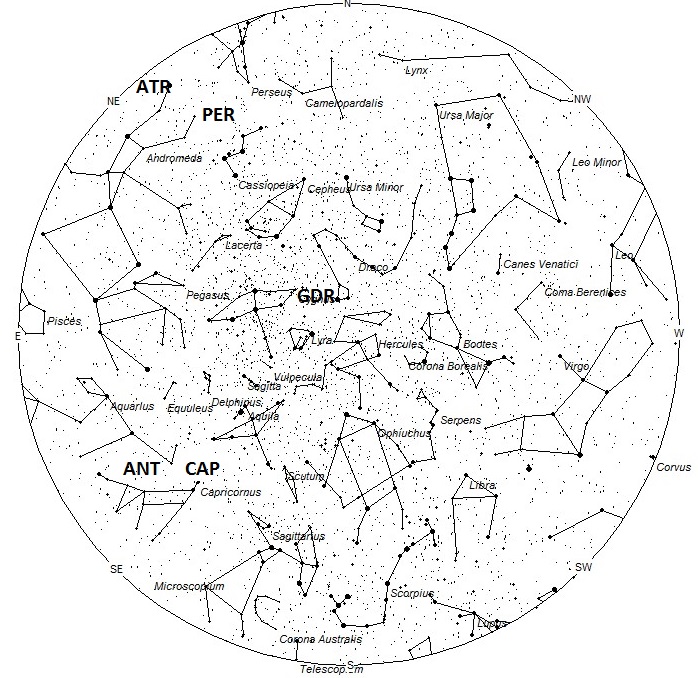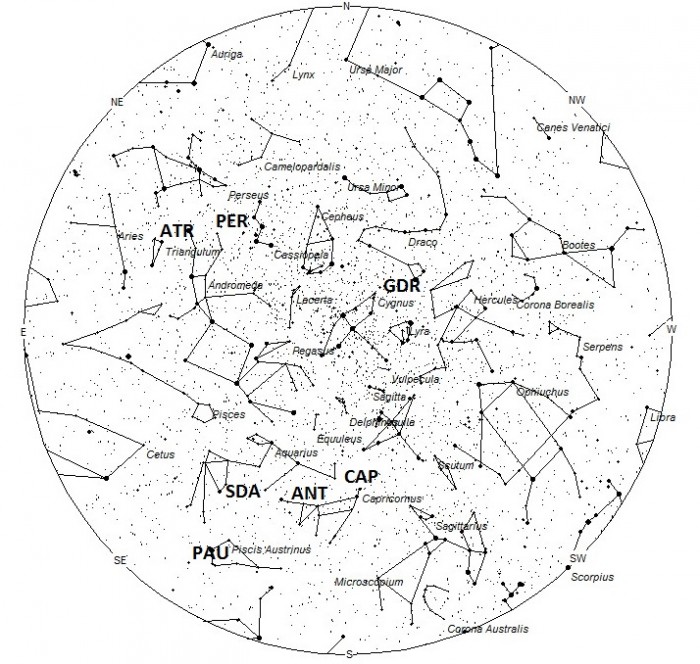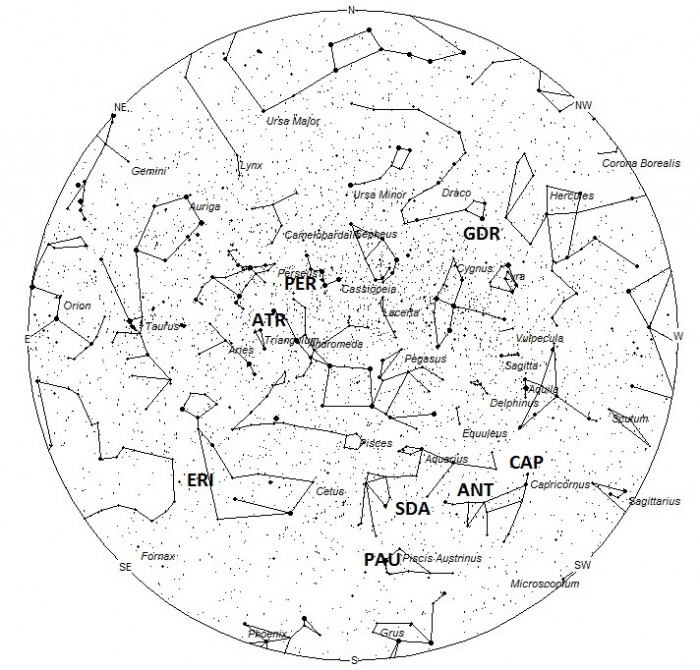
Radiant Positions at 10pm LDT

Radiant Positions at 1am LDT

Radiant positions at 4am LDT
During this period the moon reaches its last quarter phase on Monday July 29th. At this time the moon is located ninety degrees west of the sun and will rise near midnight local daylight time (LDT) as seen from mid-northern latitudes. This weekend the bright gibbous moon will interfere with observing during the more active post midnight hours. As the week progresses the waning crescent moon will still cause interference but the circumstances will improve with each passing night. The estimated total hourly meteor rates for evening observers this week is near five for observers located in the northern hemisphere and three for those viewing south of the equator. For morning observers the estimated total hourly rates should be near twenty-two as seen from mid-northern latitudes and near twenty for observers viewing from mid-southern latitudes . The actual rates will also depend on factors such as personal light and motion perception, local weather conditions, alertness and experience in watching meteor activity. Morning rates are reduced during this period due to the interfering moonlight.
The radiant (the area of the sky where meteors appear to shoot from) positions and rates listed below are exact for Saturday night/Sunday morning July 27/28. These positions do not change greatly day to day so the listed coordinates may be used during this entire period. Most star atlases (available at science stores and planetariums) will provide maps with grid lines of the celestial coordinates so that you may find out exactly where these positions are located in the sky. A planisphere or computer planetarium program is also useful in showing the sky at any time of night on any date of the year. Activity from each radiant is best seen when it is positioned highest in the sky, either due north or south along the meridian, depending on your latitude. It must be remembered that meteor activity is rarely seen at the radiant position. Rather they shoot outwards from the radiant so it is best to center your field of view so that the radiant lies at the edge and not the center. Viewing there will allow you to easily trace the path of each meteor back to the radiant (if it is a shower member) or in another direction if it is a sporadic. Meteor activity is not seen from radiants that are located below the horizon. The positions below are listed in a west to east manner in order of right ascension (celestial longitude). The positions listed first are located further west therefore are accessible earlier in the night while those listed further down the list rise later in the night.
The following sources of meteoric activity are expected to be active this week:
A new source found by SonotaCo video cameras in Japan is the July Gamma Draconids (GDR). This radiant has been found to be best seen from July 25-29, with maximum activity occurring on the 28th. The radiant is currently located at 18:42 (281) +51, which is locate six degrees east of the second magnitude star Eltanin (Gamma Draconis). The radiant is best placed near 2300 (11pm) local daylight time (LDT) when it lie highest above the horizon. Rates should be near one per hour for observers in the northern hemisphere and less than one as seen south of the equator. With an entry velocity of 27 km/sec., the average July Gamma Draconid meteor would be slow
The Alpha Capricornids (CAP) reach maximum activity on Tuesday morning from a wide radiant located at 20:20 (305) -10. This position lies in northwestern Capricornus, two degrees north of the fourth magnitude star double star known as Algiedi (Alpha Capricornii). The radiant is best placed near 0100 LDT, when it lies on the meridian and is highest in the sky. Current rates should be near one per hour as seen from the northern hemisphere and two per hour as seen from south of the equator. Don’t confuse these meteors with the anthelion meteors, which have a radiant just to the east. Both radiants need to be in your field of view to properly sort these meteors. With an entry velocity of 25 km/sec., most activity from this radiant would be slow, a bit slower than the anthelions. This radiant is well seen except for far northern latitudes where it remains twilight all night long and the radiant does not rise as high into their sky.The center of the large Anthelion (ANT) radiant is currently located at 21:08 (317) -14. This position lies in northern Capricornus, three degrees northeast of Dorsum (Theta Capricornii). Due to the large, oval-shaped radiant, activity from this source may also be seen coming from eastern Sagittarius, southern Aquila, Microscopium, Aquarius, Pisces Austrinus, as well as Capricornus. These meteors may be seen all night long but the radiant is best placed near 0200 LDT when it lies on the meridian and is located highest in the sky. Rates at this time should be near one per hour as seen from the Northern hemisphere and two per hour from south of the equator . With an entry velocity of 30 km/sec., the average Anthelion meteor would be of slow velocity.
The Delta Aquariids (SDA) reach maximum activity on July 30th from a radiant located at 22:42 (340) -16. This position is located in southwestern Aquarius,
three degrees west of the third magnitude Delta Aquarii. Hourly rates will depend on your latitude and time of night. Unfortunately the moon will be above the horizon when the radiant culminates near 0300 LDT. At this time hourly rates should range from fifteen shower members as seen from the southern hemisphere to less than five as seen from high northern latitudes. Those situated at lower northern latitudes may be able to approach ten shower members per hour if their sky is transparent. With an entry velocity of 42 km/sec., most activity from this radiant would be of average velocities.
three degrees west of the third magnitude Delta Aquarii. Hourly rates will depend on your latitude and time of night. Unfortunately the moon will be above the horizon when the radiant culminates near 0300 LDT. At this time hourly rates should range from fifteen shower members as seen from the southern hemisphere to less than five as seen from high northern latitudes. Those situated at lower northern latitudes may be able to approach ten shower members per hour if their sky is transparent. With an entry velocity of 42 km/sec., most activity from this radiant would be of average velocities.
The Piscids Austrinids (PAU) are a minor shower not well seen from the northern hemisphere. This radiant is active from July 15 through August 10. Maximum activity occurs on July 28 when the zenith hourly rate (ZHR) may reach five. These rates are only seen from the southern hemisphere where the radiant passes overhead. From mid-northern latitudes, rates of one per hour at maximum are usually seen. The radiant is currently located at 22:48 (342) -31. This position lies in southeastern Piscis Austrinus, very close to the position occupied by the first magnitude star Fomalhaut (Alpha Pisces Austrini). The radiant is best placed near 0300 LDT, when it lies highest in the sky. With an entry velocity of 35km/sec., most activity from this radiant would be of average velocities.
Activity from the Perseids (PER) is slowly increasing as we approach maximum activity on August 12. The radiant is currently located at 01:40 (025) +54. This position lies in extreme northwestern Perseus. The nearest star of note would be fourth magnitude Theta Cassiopeiae, which lies four degrees northwest of the radiant. The radiant is best placed during the last hour before the start of morning twilight when it lies highest in a dark sky. Since the maximum is not until August 12th, current rates would be near three per hour for observers situated at mid-northern latitudes and one per hour as seen from mid-southern latitudes. Activity from this source is not visible south of 40 degrees south latitude. With an entry velocity of 61 km/sec., most activity from this radiant would be swift.
The Eta Eridanids (ERI) are a newly found shower best seen from July 31 through August 17 with maximum activity occurring on August 4th. Weak activity may be seen this week with a radiant located at 02:12 (033) -15. This area of the sky is situated in southeastern Cetus, six degrees west of the fourth magnitude star Pi Ceti. This area of the sky does not rise until 0200 LDT and is located highest in a dark sky during the last hour before dawn. Rates are expect to be less than one per hour no matter your location. With an entry velocity of 66 km/sec., the average Eta Eridanid meteor would be swift.
A new source found by IMO video cameras to be active this time of year are the Alpha Triangulids (ATR). This radiant has recently been found to be active later than previously published, with the activity period ranging from July 25 through August 20 with maximum activity occurring on July 27. Current rates would be near one per hour as seen from the northern hemisphere and less than one from the southern hemisphere. The radiant is currently located at 02:16 (034) +41, which is actually situated in eastern Andromeda, two degrees southeast of the famous second magnitude star double star Almach (Gamma Andromedae). The radiant is best placed during the last hour before dawn, when it lies highest in a dark sky. With an entry velocity of 68 km/sec., the average Alpha Triangulid meteor would be swift.
As seen from the mid-northern hemisphere (45N) one would expect to see approximately nine sporadic meteors per hour during the last hour before dawn as seen from rural observing sites. Evening rates would be near three per hour. As seen from the mid-southern hemisphere (45S), morning rates would also be near five per hour as seen from rural observing sites and two per hour during the evening hours. Locations between these two extremes would see activity between the listed figures. Morning rates are reduced due to moonlight.
The table below presents a list of radiants that are expected to be active this week. Rates and positions are exact for Saturday night/Sunday morning unless indicated in the verbal description of each shower.| SHOWER | DATE OF MAXIMUM ACTIVITY | CELESTIAL POSITION | ENTRY VELOCITY | CULMINATION | HOURLY RATE | CLASS |
| RA (RA in Deg.) DEC | Km/Sec | Local Daylight Time | North-South | |||
| July Gamma Draconids (GDR) | Jul 28 | 18:42 (281) +51 | 27 | 00:00 | 1 – <1 | IV |
| Alpha Capricornids (CAP) | Jul 30 | 20:20 (305) -10 | 25 | 01:00 | 1 – 2 | II |
| Anthelions (ANT) | - | 20:44 (311) -17 | 30 | 01:00 | 1 – 2 | II |
| Delta Aquariids (SDA) | Jul 30 | 22:42 (340) -16 | 42 | 03:00 | 5 – 7 | I |
| Pisces Austrinids (PAU) | Jul 28 | 22:48 (342) -31 | 35 | 03:00 | 1 – 2 | II |
| Perseids (PER) | Aug 12 | 01:40 (025) +54 | 61 | 06:00 | 3 – 1 | I |
| Eta Eridanids (ERI) | Aug 04 | 02:12 (033) -15 | 66 | 07:00 | <1 – <1 | IV |
| Alpha Triangulids (ATR) | Jul 27 | 02:16 (034) +41 | 68 | 07:00 | 1 – <1 | IV |
0 comments:
Post a Comment